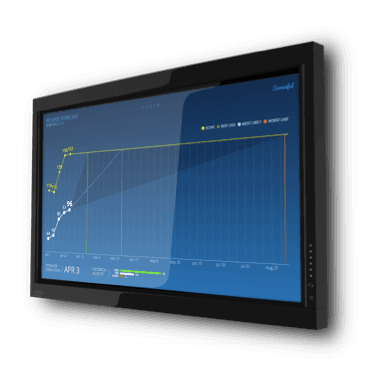Use TV mode to display project status on a big screen
Mar 28, 2017
Our favourite use case of Screenful is rotating the dashboard on a TV screen at the office. We believe that such screens can play an important role in communicating status and visualising progress. While there’s plenty of data collected in your task management tool, the fact is that not everyone logs into those tools on a daily basis. That’s what our TV mode is for, taking data out of the tools and putting it on a wall so that people can see it.
Turn your office TV into an information radiator
Ready to unleash your data? Great! Follow these steps to set up Screenful on your office TV.
1 Select the screens for rotation
The first step is to select the screens to include in your dashboard. Not all of the screens are equally relevant for keeping visible all the time. Some information, like which tasks are currently in progress, is something that you probably want to see all the time. If you're doing sprints, the sprint burndown is an obvious chart to show. If there are certain metrics that you specifically want to improve on, then those should be included as well. Remember, less is more when it comes to tracking KPIs!
Start by reducing the number of screens to only those that are essential. Notice that If you have multiple Screenful dashboards, you can consolidate screens from all of them into one rotating slideshow. Pay also attention to how you name your screens so that they make sense to even a random passer by!
2 Select hardware
We’re always on a search for hardware that would be a perfect fit for our dashboard. The device of our dreams is small in size yet powerful enough. It should be easy to setup by even a non-technical person. The less hassle with cables, the better.
Airtame is one good choice as it allows you to set up your dashboard remotely via your laptop. However, you can use any hardware that runs a modern web browser such as these small yet powerful devices available for Android, Chrome OS and Windows. Notice that some built-in browsers in TVs may not render content properly. This previous blog post documents our initial setup which has been working till today (except the leg part, which was retired after we found it a bit too much space consuming).
3 Configure a direct URL
Entering your credentials in the login screen can be problematic when working on a device attached to a TV. However, you can skip the login screen by constructing a shareable link to your dashboard. Notice that you can use a parameter mode=tv to turn the UI to tv mode by default.
4 Switch to TV mode
TV mode is a special mode of UI that is optimised for viewing content in an office TV or big monitor. You can activate the TV mode manually by clicking TV mode link on the setup menu.
In this mode, excess UI elements such as tool icons are removed and the screen title and the board name are shown in a more visible font. That way, the UI will be more readable from a distance. Auto-rotation is turned on so that a screen will automatically switch to another once per two minutes.
After clicking the TV mode link, make sure to switch your browser to fullscreen or presentation mode so that the browser address bar gets hidden too. The end result should look something like in the picture below:

Once done, it will just keep running and there's no need to touch it again. Any changes you make to your dashboard settings on your laptop will eventually be reflected in TV.
Summary
A key principle of Kanban is to visualise work. Information radiators are a great way to visualise the work as they're constantly visible. You walk into the room and you immediately see what is going on.
Once you have your hardware ready, just pick the screens you want to rotate on your dashboards. Place your TV screen so that people can see it from distance but also close by. Broadcasting your key information can help to spark the right conversions and to focus on the things that matter.
Let us know if you have questions or feedback by contacting hello@screenful.com. To stay on the loop, read our blog, or follow us on LinkedIn.

